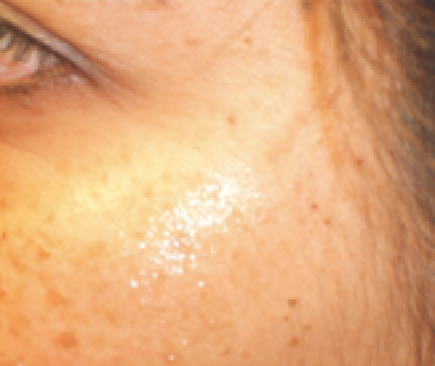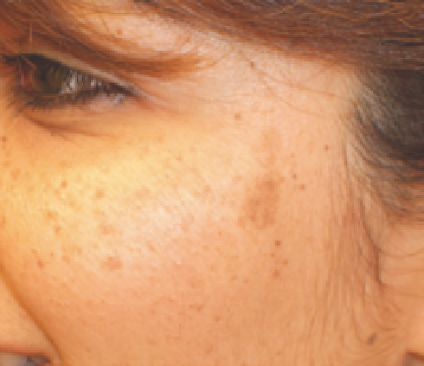Biomedical Engineering Reference
In-Depth Information
(
A
)
(
B
)
Figure 3.3
(
A
) Multiple solar lentigines. (
B
) Clinical appearance after treatment.
Source
: Photos courtesy of Mitchel P. Goldman, MD.
Ephelides
Ephelides (commonly known as freckles) are well demarcated,
tan- to dark-brown macules that occur on sun-exposed skin
and darken in response to sunlight. Ephelides appear early
in childhood and increase in number during the summer.
Their incidence decreases with age. Axillary freckling, the
only type that appears on a non-sun-exposed skin, is seen in
von Recklinghausen disease (neurofi bromatosis).
Histologically, ephelides show normal epidermis without
elongation or branching of the rete ridges, as in the case of
lentigines. Hypermelanization is generally confi ned to the
basal cell layer. The total number of basal melanocytes does
not increase, but melanosomes and melanocytes grow in size
and become more active than before (20-22).
Treatment of ephelides usually consists of sunscreen applica-
tion and sun avoidance. Hydroquinone, alfahydroxy acids, and
tretinoin can also diminish freckling if applied regularly. When
requested for cosmetic purposes, similar to lentigines, the three
QS lasers [QS ruby (694 nm), QS alexandrite (755 nm), and
QS FD Nd:YAG (532 nm)] and KTP (532 nm) can be used to
treat these lesions (22). Noncoherent, broadband IPL is also
an effective modality in the treatment of ephelides (25). Re-
exposure to ultraviolet light without adequate sun protection
stimulates recurrence and occurrence of new ephelides.
Case 4
Ephelides
A 54-year-old woman with numerous ephelides presented for evaluation and discussion of treatment options (Fig. 3.4A). The
ephelides were treated with the QS 532 nm Nd:YAG laser utilizing a 6-mm spot size and a fl uence of 1.5 J/cm
2
. Signifi cant
improvement was noted at the 6-week follow-up (Fig. 3.4B).
(
A
)
(
B
)
Figure 3.4
Ephelides (
A
) before and (
B
) 6 weeks after treatment with QS 532-nm Nd:YAG.



















